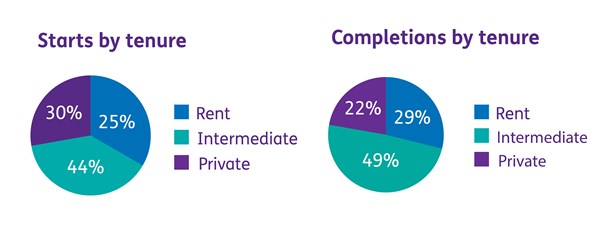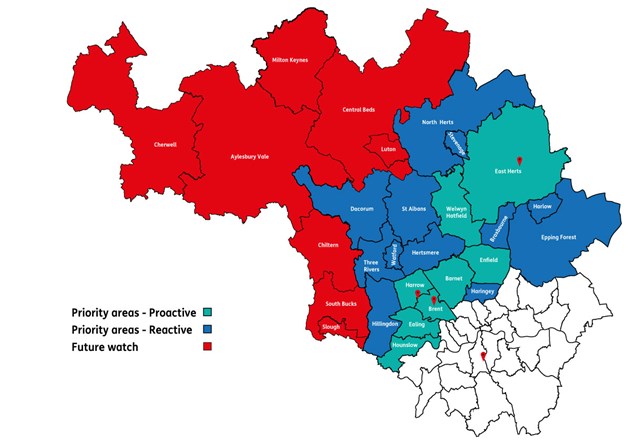Our Growth Strategy for 2018-23
Our Growth Strategy sets out how Network Homes intends to meet its growth ambitions between 2018-23. It sits within the context of our Five Year Strategy 2018-23.
Introduction
Since the last version of the strategy (in early 2016), the external environment for housing association development has changed radically. This is through a combination of the coronavirus (COVID-19) pandemic, significantly revised government policy, Greater London Authority (GLA) policy change following the election (and re-election) of Sadiq Khan as Mayor, the consequences on the sales and construction markets following Brexit and building safety remediation following the tragic Grenfell Tower fire.
We’re seeing a new environment of far greater opportunities created by policy change and additional funding, mixed with difficult challenges such as the limitations of the current cross-subsidy model in what is likely to remain a slower housing market for some years, stronger competition from larger, financially very strong organisations, and heightened quality and health and safety requirements in new developments.
The housing affordability challenge across London and the South East remains acute and demands that we be ambitious in our growth and in our efforts to deliver more affordable homes.
Objectives and targets
The Growth Strategy operates in the context of our organisational Five-year Strategy 2018-23. Under the ‘Increasing the number of homes for people in housing need’ strategic objective, we aspire to start 1,000 affordable homes by March 2023. In achieving this objective, we will:
- Meet our 1,752 new homes target as a GLA Strategic Partner for SHP 2016-21 and look to extend this as with the delivery of a further 350 homes in 2021/22.
- Establish a strategic partner arrangement with Homes England, possibly in concert with one or more HA partners
- Ensure at least 60% of all new homes are for affordable tenures
- Ensure at least 25% of all new homes are for ‘genuinely affordable’ rent (London Affordable Rent, London Living Rent, social rent, or S.106 restricted rents)
- Meet a minimum customer satisfaction level of 85% with our new homes
- Increase our financial capacity through a mixture of Development Agency, Joint Venture and build cost efficiencies
- Manage development and financial risk effectively.
As well as a focus on volume of homes, these targets emphasise our desire to ensure we deliver on our social purpose as a housing association. Specifically, our plan is to achieve 5,000 starts on site by 2023/24 and 4,268 new home completions based upon our current and forecast pipeline.
The above pie charts show the current anticipated split within our programme between tenures. We can expect the numbers within each tenure bracket to change. Our preference, subject to our financial capacity to deliver, including raising the required financing and providing sufficient security, will be to increase the volume of more affordable rented homes and reduce our level of exposure to sales. Cross-subsidy will remain a vital method of supporting the building of affordable rented homes, however, so there is a difficult financial and ethical balance to be struck.
Where are we developing?
We have identified the priority areas where there is significant opportunity, openness to competition and where we are able to reinforce our management concentration and achieve strategic geographic strongholds. We have identified priority 1 areas where we should be proactive, priority 2 areas where we will continue to be reactive to opportunities and areas where we should maintain a watching brief for future. This is summarised in the map below (click to enlarge):
It is important to note that the prioritisation approach will be reviewed regularly and may change as our business strategy and priorities and the external operating environment evolve.
Who are we building for?
Network Homes is a whole market provider – we produce homes across the tenure spectrum to rent and buy. Housing need now stretches over a broad swathe of the population and while the cross-subsidy model prevails it will continue to require us to build homes for market sale.
Within that context and our financial capabilities, however, we want to focus as far as we can on our primary objective as a housing association of helping those in most need.
Genuinely affordable homes
We have a clear target within our Five Year Strategy to deliver a minimum of 25% of all new homes for ’low rent’ (social rent, London Affordable Rent, London Living Rent, and S.106 local authority restricted rents) and a minimum of 60% of our overall pipeline should be for affordable products (low rents, Affordable Rent, and shared ownership). We will look to maximise delivery of genuinely affordable homes whenever possible.
We recognise that the shared ownership market in parts of London has become too expensive. Whilst shared ownership provides important cross-subsidies to support our rented programme, we will set maximum sales values and maximum household incomes for different parts of London and Herts to help us direct our efforts towards those who would be unlikely to afford an open market purchase within a reasonable period.
Intermediate market rent and Build to Rent
Many more people are reliant on the private rented sector than previously, and for longer periods. Yet the rise in private rents in recent years has stretched household budgets to the limit.
We see potential opportunities in providing an intermediate market rent product, to go alongside our grant-funded Affordable Rent programme, particularly in higher cost locations where shared ownership is becoming less popular with local authorities.
We will also explore the potential to deliver ‘Build to Rent’ homes as part of larger developments where appropriate but will seek to sell these blocks on to investors rather than hold the asset which eats into our capacity to deliver homes for genuinely affordable rent. We will be proactive in exploring the potential of management-only contracts with developers and investors of build to rent schemes, particularly on our own sites.
Help to Buy
The Government’s Help to Buy programme is due to end in 2023 and be restricted to first time buyers only from 2021. While it continues, we will aim to provide any open market sales at values which allow customers to access the scheme to support their purchase.
Housing for older people
Our main focus will be on general needs homes. We recognise the growing importance of older people’s housing as the older population rises, but we have several existing sheltered homes which require remodelling to bring them up to modern day standards and potentially increase the number of homes on each site. This will be our main priority for this market, though we will consider new development opportunities for older people which have a wider strategic rationale.
We will conduct further research into the likely future shape of the older people’s housing market and the kind of development and management model which will be most effective for Network over the long-term.
Ensuring construction quality
The tragedy at Grenfell Tower and national media stories concerning poor quality in new build housing association homes have highlighted the issue of construction quality in social housing as never before. All housing associations need to respond effectively. It is essential that customers have confidence in the health and safety of their homes and trust in us as their landlord.
The Farmer Review and Hackitt Review further illustrated that the construction industry needs to modernise its approach to development and incorporate new approaches and technologies to manage costs, environmental efficiency, health and safety, skills shortages, and broader operating risks, such as Brexit, more effectively.
This is likely to mean a level of increased cost in the early stages of projects with a view to delivering greater out-turn cost and quality certainty, faster unlocking of capacity through shorter construction timescales, fewer defect-related management issues, and better environmental sustainability.
New ways of working
Adopting new ways of working, such as offsite construction, offers another route to overcoming some of the quality, environmental and cost issues housing associations have experienced in recent years. It is also being actively encouraged by the GLA and Homes England through their grant programmes and other special funding streams.
Our first offsite construction scheme at Press House showed the potential to cut waste, construction time and site journeys. There were some issues encountered with the accreditation that impacted on the ability of shared owners to access mortgage finance so these lessons will be addressed as part of a “Lessons Learned” review. While we have created the potential for further offsite construction on sites we own, we need to improve our knowledge of different methods and move more decisively towards using new technologies. We will progress incrementally, with a clear goal to increase the proportion of homes that are being precision-manufactured year-on-year through to 2023.
The Hackitt Review argued that the sector should embrace Building Information Management (BIM) to ensure good knowledge of component parts is available for health & safety reasons. But in a business where the commitment to buildings is long-term and reinvestment is critical to maintain quality and value of product, there are many other reasons to develop a strong database of knowledge about each development as built, including reduction of future management costs and better data quality. This also sits well with our Innovative Ways of Working (iWow) agenda to modernise our overall approach to technology.
We will establish a BIM working group involving internal teams and external consultants and develop template/standard property types using BIM to go into our design briefs. We will also provide staff with comprehensive training on BIM and appoint an internal champion.
Partnerships
Partnership working offers a range of potential advantages. As the financial risks of our development programme rise, partnership working is increasingly attractive. It can allow us to share risk on large and complex schemes, gain entry into new localities or ways of working, and offers the opportunity to use a partner’s differing expertise and to learn for the future. Over the period of the strategy we will:
- Actively work more closely with our key local authority partners to maximise delivery
- Increase development agency work to maximise delivery
- Work to develop a strategic partnership with Homes England
- Ensure all partnership and regeneration arrangements meet the criteria we have set
- Use our new geographical focus to be more proactive at developing key relationships in our eight priority boroughs
- Use the findings from our 2019 stakeholder perceptions survey to inform our approach to partnership working in different areas.



